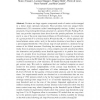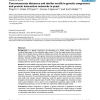258 search results - page 15 / 52 » Predicting protein folding pathways |
BMCBI
2008
13 years 9 months ago
2008
Background: Amino acid sequence probability distributions, or profiles, have been used successfully to predict secondary structure and local structure in proteins. Profile models ...
BMCBI
2010
13 years 9 months ago
2010
Background: Phosphorylation events direct the flow of signals and metabolites along cellular protein networks. Current annotations of kinase-substrate binding events are far from ...
ISBRA
2007
Springer
14 years 3 months ago
2007
Springer
Proteins are large organic compounds made of amino acids arranged in a linear chain (primary structure). Most proteins fold into unique threedimensional (3D) structures called inte...
BMCBI
2005
13 years 9 months ago
2005
Background: In a genetic interaction, the phenotype of a double mutant differs from the combined phenotypes of the underlying single mutants. When the single mutants have no growt...
DMKD
2003
ACM
14 years 2 months ago
2003
ACM
Given a known protein sequence, predicting its secondary structure can help understand its three-dimensional (tertiary) structure, i.e., the folding. In this paper, we present an ...


